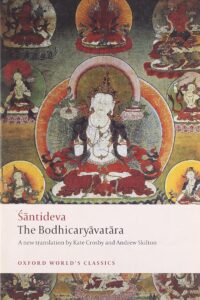Anger is always the Enemy: Śāntideva’s Chapter on Patience
An eighth-century CE Indian Buddhist monk argues that anger is always irrational and harmful to the angry person.
One of the most influential medieval Indian Buddhist philosophers was Śāntideva, an eighth century monk who lived at the north Indian monastic university of Nalanda. Śāntideva is well-known for his poetic descriptions of the virtues of the bodhisattva, the being (sattva) of great compassion whose mind is focused on attaining the awakening (bodhi) of a fully enlightened Buddha for the sake of all living beings. His most influential text, the Guide to the Practices of Awakening (Bodhicaryāvatāra; hereafter, Guide), is a short guide to the bodhisattva path. In its ten chapters, the Guide provides a series of trainings to develop the bodhisattva’s virtues, such as patience (kṣānti), effort (vīrya) and wisdom (prajñā).


In contemporary times Śāntideva’s Guide has become a global classic, taught in Dharma centers and universities all over the world. Part of the text’s global appeal is due to its evocative poetic verses, such as the following illustration of the bodhisattva’s limitless compassion.
For as long as space endures and for as long
as the world lasts, may I live dispelling the
miseries of the world.
(Wallace and Wallace 1997; Guide 10:55)
One of the most influential of the Guide’s chapters is the sixth, devoted to developing patience (kṣānti), the antidote for anger. The chapter is largely composed of a series of arguments that anger is irrational, given that it harms its possessor and distorts one’s perception of the world. Śāntideva believes that contemplating these arguments repeatedly will weaken our propensity to become angry. Below, I summarize two of the chapter’s strategies for eliminating anger.
Anger is Always Harmful
Śāntideva begins chapter six of the Guide with a series of contemplations of the harm anger does to its possessor.
The mind does not find peace, nor does it enjoy pleasure
and joy, nor does it find sleep or fortitude when the thorn
of hatred dwells in the heart.
Even dependents whom one rewards with wealth and honors
wish to harm the master who is repugnant due to his anger.
Even friends fear him. He gives, but is not served. In brief,
there is nothing that can make an angry person happy.
(Wallace and Wallace 1997; Guide 6:3-5).

In these verses Śāntideva argues that anger, the wish to harm other living beings, is damaging to its possessor in many ways. At the psychological level, it disrupts and destabilizes the mind. Śāntideva’s use of the image of the thorn in the first verse is central to his method, given that it helps draw the attention of the reader to their own experience. Anger is like a thorn in being painful; in addition, just as a thorn sticks into the flesh, anger works its way into our minds, dominating and distorting our experience for hours, or days, or even in some cases years. The result, as pointed out in verses four and five, is that we cannot enjoy life, or even sleep, ruminating instead on the harm we have experienced from the one we hate. At the social level, the angry person is feared even by those in close relationship with them. Family members and friends are nervous around them, since they never know when the angry person might lash out. Even when the angry person behaves generously, their gifts will be accepted fearfully, given that close contact with them has resulted in verbal or even physical violence in the past.
Contemplating the harm anger does serves two purposes for Śāntideva, both of which are central to his moral thought. First, it develops the character of the bodhisattva by weakening and finally eliminating their propensities to become angry. This enables the bodhisattva to work more effectively for sentient beings’ well-being. Second, by protecting them from the harmfulness of anger, it develops the bodhisattva’s own happiness. As Śāntideva states explicitly elsewhere, the bodhisattva path, which promotes deep altruism for all living beings, is also of deep and lasting benefit to the virtuous bodhisattvas themselves. (Wallace and Wallace 1997; Guide 7:29-30).

Anger Arises from Emotional Pain
Let us say that arguments like the one summarized in the last section have convinced a person that anger is harmful and should be eliminated. This will be challenging, given that most humans feel at least some kind of irritation frequently throughout life. Chapter six of the Guide gives well over a dozen overlapping but distinguishable trainings to aid a person in the elimination of anger. A strategy Śāntideva uses early in the chapter is to examine the psychological causes of anger, which he identifies as discontent (daurmanasya), a kind of mental pain, which is itself caused by the frustration of our self-centered desires. Śāntideva lays out his therapeutic strategy in the following two verses:
Finding its fuel in discontent originating
from an undesired event and from an
impediment to desired events, anger
becomes inflamed and destroys me.
Therefore, I shall remove the fuel of that
enemy, for that foe has no function other than to harm me.
(Wallace and Wallace 1997; Guide 6:7-8).
Verse seven reemphasizes Śāntideva’s earlier claim about the dangerous effects of anger, but it also identifies discontent (daurmanasya) as anger’s psychological cause. Discontent is a kind of mental pain which precedes but is distinct from anger. For example, imagine we are criticized at work. The emotional pain most of us would feel when this happened is what Śāntideva means by discontent. A split second later, many of us would become angry—we would feel a mental wish to lash out or harm the one who caused us this mental pain. The claim Śāntideva is making is that such feelings of anger arise because we have been emotionally wounded; we lash out as a result of our susceptibility to suffering. The strategy to wholly eliminate anger, therefore, cannot be simply to fix things in the world, since there will always be unpleasant experiences that we have to endure. Rather, we must strengthen the mind so that it can response flexibly but stably to difficult circumstances. Moreover, laying out the psychological cause of anger in this way shows that anger can be wholly eliminated from a person’s experience. Since anger arises because of discontent, if we can eliminate discontent then we will never become angry.
The key to eliminating anger, therefore, is to remain joyful in situations that ordinarily cause emotional pain (see Guide 6:9). Of course, this is no easy task! Śāntideva, like many Buddhists, has an enormously optimistic conception of the malleability of the mind, however, and thinks that completely eliminating mental pain and negative emotions is possible. The point is not to simply repress these negative mental states, nor to blindly ignore painful situations, but rather to develop a mental resilience which is able to remain confident and optimistic even when facing difficult circumstances. This is accomplished by taking a broader perspective on the challenges we face. For instance, when we are insulted, we can remind ourselves that our enemies are themselves dominated by negative emotions and have little control over their behavior (Guide 6:34-38). The appropriate attitude towards them, therefore, is not anger but compassion.


One of Śāntideva’s simplest arguments to reduce discontent may also be one of his most effective.
If there is a remedy, then what is the use of frustration?
If there is no remedy, then what is the use of frustration?
(Wallace and Wallace 1997; Guide 6:10).
This simple but powerful argument claims that discontent can never serve a useful purpose. Imagine that we encounter a distressing situation. If we are able to resolve it, then there is no need to feel discontent; we can simply get to work at fixing the problem. If the situation cannot be resolved, however, then feeling discontent is simply an additional suffering added to whatever discomfort we are experiencing. The implied conclusion of the argument is that there is no situation whatsoever in which it is beneficial to experience discontent. Recognizing this, Śāntideva thinks, will weaken our propensity to feel discontent. If we succeed in eliminating it, then anger also cannot arise, given that discontent is its causal condition.
These summaries of Śāntideva’s arguments give only a quick taste of the ethical reasoning, interwoven with extended meditations, that he offers as techniques to develop the moral character of the bodhisattva. Hopefully, however, they give some indication of why the Guide has attained the status of a global classic.
Further Reading:
Short introductions to Śāntideva’s thought include Goodman 2016b and Harris 2021. An accessible and insightful analysis of Mahayana conceptions of patience is Bommarito 2014. Dalai Lama XIV 1997 provides a commentary on Śāntideva’s chapter on patience. An excellent translation of the Guide is Wallace and Wallace 1997. A translation with extended introduction to Śāntideva’s other text, the Training Anthology, is Goodman 2016a. Heim 2020 provides a short introduction to Buddhist Ethics, with a chapter devoted to Śāntideva.
Bommarito, Nicolas. 2014. “Patience and Perspective.” Philosophy East and West 64(2): 269-286.
Dalai Lama XIV. 1997. Healing Anger: The Power of Patience From a Buddhist Perspective. Ithaca, New York: Snow Lion.
Goodman, Charles. 2016a. The Training Anthology of Śāntideva: A Translation of the Śikṣā-samuccaya. New York: Oxford University Press.
Goodman, Charles. 2016b. "Śāntideva." In The Stanford Encyclopedia of Philosophy, edited by Edward N. Zalta.
Harris, Stephen E. 2021. “Śāntideva’s Introduction to the Practices of Awakening (Bodhicaryāvatāra).” Oxford Research Encyclopedias: Religion. Oxford University Press
Heim, Maria. 2020. Buddhist Ethics. Cambridge: Cambridge University Press.
Wallace, Vesna and Wallace, Alan. 1997. A Guide to the Bodhisattva Way of Life (Bodhicaryāvatāra) by Śāntideva. Oxford: Oxford University Press.
Williams, Paul. 1998. Altruism and Reality: Studies in the Philosophy of the Bodhicaryāvatāra. Richmond, Surrey: Curzon.
© Stephen Harris and Leiden Medievalists Blog, 2023. Unauthorised use and/or duplication of this material without express and written permission from this site’s author and/or owner is strictly prohibited. Excerpts and links may be used, provided that full and clear credit is given to Stephen Harris and Leiden Medievalists Blog with appropriate and specific direction to the original content.


